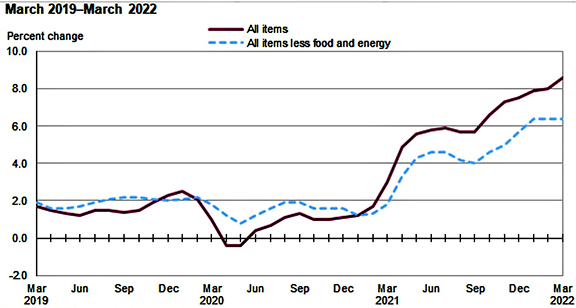KANSAS CITY, Kan. – Prices in the Midwest Region, as measured by the Consumer Price Index for All Urban Consumers (CPI-U), advanced 1.3 percent in March, the U.S. Bureau of Labor Statistics reported Tuesday.
Higher prices for gasoline were the largest contributing factor to the March increase. The food index rose in March due to higher costs for food at home, and the index for all items less food and energy increased as a result of higher shelter costs.
Over the last 12 months, the CPI-U rose 8.6 percent. The index for all items less food and energy increased 6.4 percent over the year. Energy prices jumped 29.3 percent, largely the result of an increase in the price of gasoline. Food prices were up 10.3 percent. (See chart 1.)

Food
Food prices increased 1.4 percent for the month of March. (See table 1.) Prices for food at home increased 1.8 percent, and prices for food away from home rose 0.7 percent for the same period.
Over the year, food prices were up 10.3 percent. Prices for food at home increased 11.3 percent since a year ago, and prices for food away from home advanced 8.4 percent.
Energy
The energy index advanced 9.8 percent over the month. The increase was due to higher prices for gasoline (19.4 percent). Prices for electricity edged down 0.1 percent, and prices for natural gas service decreased 1.4 percent for the same period.
Energy prices rose 29.3 percent over the year, largely due to higher prices for gasoline (46.0 percent). Prices paid for natural gas service jumped 26.3 percent, and prices for electricity advanced 5.0 percent during the past year.
All items less food and energy
The index for all items less food and energy rose 0.4 percent in March. Higher prices for shelter (0.6 percent) and medical care (0.6 percent) were partially offset by lower prices for education and communication (-1.0 percent).
Over the year, the index for all items less food and energy increased 6.4 percent. Components contributing to the increase included new and used motor vehicles (23.3 percent), shelter (5.1 percent), and household furnishings and operations (11.3 percent).
